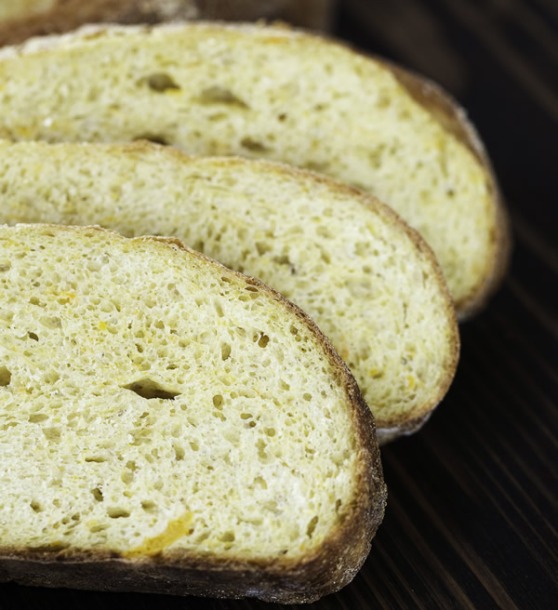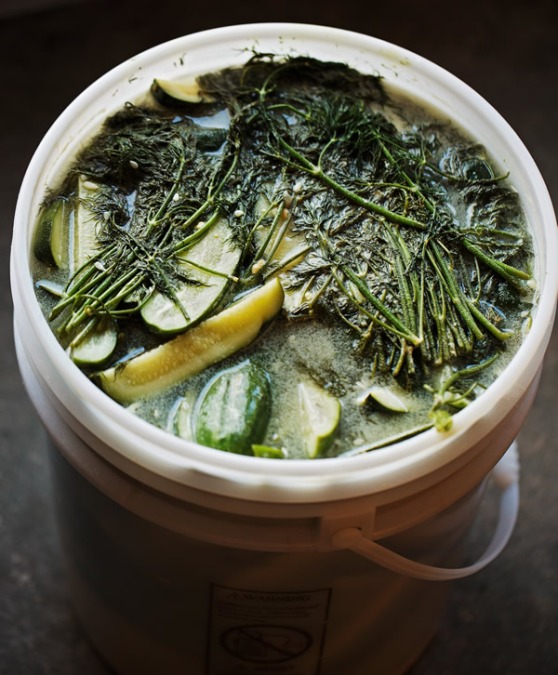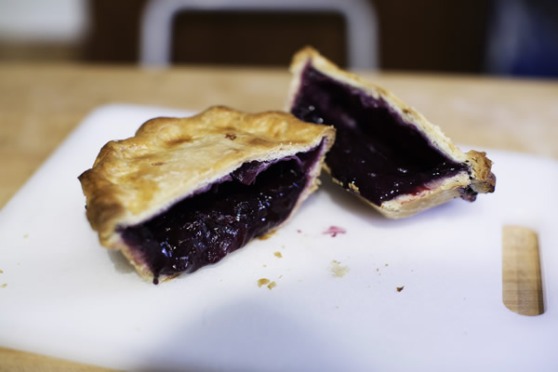
As soon as school starts in the fall, we begin fielding calls from customers asking when this bread will be back on the shelves. It has a limited life cycle in the bakery, as we bake it during the couple of months when we can source the pumpkins from nearby farms.
Notice that we call for corn flour, which has a finer grind than cornmeal and absorbs liquid better, resulting in a smoother final crumb. You can find it in specialty grocery stores and online.
This bread has a sweet, moist, and tighter crumb than some of the other breads we make, and the crust has a bit more give. It makes amazing toast and grilled cheese sandwiches, its yellow hue crisping to a beautiful golden in the pan. You can easily shape these into loaf pans for more convenient sandwich slices; we make them as pumpkinesque rounds.
Note: If you do not have bannetons (the coiled cane molds that bakers use), you can use a
large mixing bowl lined with a smooth cotton dish towel.
Cornmeal-Pumpkin Hearth Bread
The Farm Stand Special
Overview
Yield: Three 1 lb 10 oz loaves
Desired Dough Temperature: 85˚F
Mixing Time: 40 minutes
Bulk Fermentation: ~2 hours
Proofing Time: ~2 hours
Baking Time: ~25 minutes
Cooling Time: ~1 hour
12 Hours Before the Bake
Mix your poolish
15 oz 75˚F water
15 oz bread flour
2 g / .5 tsp instant yeast
Baking Day
1 lb 4.75 oz white bread flour
8.75 oz corn flour
1 lb 13.5 oz poolish
8.75 oz 90˚F water
8.75 oz roasted pumpkin (see below)
2.25 oz extra- virgin olive oil
1.5 oz honey
25 g / 3.5 tsp fine sea salt
5 g / 1.25 tsp instant yeast
Combine your flours in your large mixing bowl. In another bowl, mix your poolish, water, roasted pumpkin, olive oil, and honey, and remember to keep that water warm to give your yeast a comfortable atmosphere to grow. Swirl those ingredients around with your hand to combine. Then, dump your flours on top of the liquid ingredients, and mix it by hand for about 30 seconds until it comes together in a shaggy mass. Don’t forget to scrape the bottom and sides of the bowl regularly; you want all of that flour hydrated and don’t want to see any dry spots. Set aside in a warm place, at least 80˚F, for 30 minutes.
Sprinkle the salt and yeast on top of the dough, which will have developed a good deal of strength by now. Grab a four-finger pinch of the dough and pull. It should stretch out like chunky taffy rather than just tear off. Incorporate the salt and yeast into the dough while continuously pushing the sides of the dough into the middle while turning the bowl. After a minute of this, the dough should be pulling away from the sides of the bowl and developing a bit of a sheen, and you shouldn’t feel any crunchy salt crystals. Cover the bowl, and put it in your warm place for 30 minutes.
Turn your dough onto a lightly floured surface and give it your four-fold by gently patting it out, folding the left side into the middle, the right side overlapping the left, the top into the middle, and finally the bottom overlapping the top. It should make a tight little package – this is how we’re building the dough’s strength, and after every fold the dough’s volume should increase. It should consistently feel warm and active. Roll the dough over and place it, seam side down, back into the bowl. Repeat every 30 minutes (you’ll fold the dough three times in total) until the dough is strong but puffy, warm to the touch, and holds a fingerprint when pressed into the surface. The whole process will take about 2 hours with a warm kitchen and warm dough.
Once your dough is ready to cut, turn it out onto your floured work surface. Using your bench knife and scale, divide into three l lb 10 oz pieces. Gently pre-round the dough into rounds, being careful not to compress the dough too much, and place seam side down on your work surface. Cover and rest for 20 minutes to build a bit more strength into the loaf before final shaping. Dust three bannetons/smooth towel-lined bowls with corn flour. Then take your rested rounds and gently but firmly shape them into rounds again. If your seams feel like they’re coming undone when you lift the loaf up, give it a few minutes sitting seam side down on the table to seal it and next time, use less flour for shaping. The dough’s moisture should be enough to seal the loaf closed. Place your shaped loaves seam side up in your bannetons/smooth towel-lined bowl,s cover with a cloth or plastic wrap, and place in your trusty warm spot.
While your dough is proofing, place your baking stone on the lowest rack in your oven, and your cast-iron pan on the highest rack. Preheat the oven to 450˚F. Check in on your bread periodically; if the surface feels dried out, spray it with a bit of water to allow for maximum expansion. If it feels cold, make it warmer. This may take up to 2 hours depending on the conditions of your kitchen; remember, proof to a result, not a time. If it doesn’t feel ready to bake, it probably isn’t. The loaf is ready to go in when it feels very airy and holds a fingerprint when pressed into the surface.lip the loaves over onto your peel. It might take couple of batches to bake all your bread, depending on your oven size. Using a sharp paring knife or a razor, slash the surface of the loaves in your desired pattern. Now grab three ice cubes from the freezer.
Being careful not to keep the oven door open too long and let the heat out, open the oven, slide your loaf onto the stone, throw the three ice cubes into the cast-iron pan, and close the door. After 5 minutes, quickly open the door and spray the interior of the oven with water. Continue baking until the loaf is evenly browned, about 25 minutes, and has a nice hollow when you tap it on the bottom. Let cool for at least 1 hour before cutting.
Roasted Pumpkin
The best pumpkins for this recipe are the smaller ones called sugar pumpkins. Choose those that are 8 to 10 inches in diameter. Wash any remaining field dirt off the surface, and knock the stem off with a hammer, the side of your table, or the back of a chef’s knife (careful with that last one). Bisect the pumpkin top to bottom (starting at the stem), and scoop out the seeds. Place the two halves cut side down on a sheet pan and roast at 400˚F until the skin starts to collapse and a skewer passes through the flesh easily, 45 to 60 minutes. Let cool, and then scoop the roasted flesh off the skins. Refrigerate until ready to use. Remember to warm the pumpkin to room temperature before using in this recipe (or else you’ll sandbag your dough temperature), and squish it through your fingers to smooth it out a bit before incorporating it into the other ingredients.



